Workplace safety is crucial, regardless of a business, its size or its industry. Without the proper workplace safety measures in place, a company puts its employees, customers, brand reputation and revenues in danger. Additionally, failure to teach employees how to maintain a safe work environment may lead to on-the-job accidents, injuries and, worst of all, fatalities.
The U.S. Occupational Safety and Health Administration (OSHA) reported 5,190 employees were killed on the job in 2016. Meanwhile, OSHA has partnered with companies nationwide to find the best ways to limit workplace dangers. To date, OSHA and its partners have been successful in their workplace safety efforts, reducing the average number of worker deaths per day from 38 in 1970 to 14 in 2016.
Of course, even a single workplace accident or injury can have far-flung ramifications. But with the right approach to workplace safety, a company can develop initiatives to engage and inform its workforce about the short- and long-term ramifications of on-the-job dangers.
Why Should Your Business Prioritize Workplace Safety?
There are lots of reasons to prioritize workplace safety, and these include:
- You can create a safe, productive work environment. Every business wants to provide its employees with a safe place to work. At the same time, every business wants to help its workers maximize their potential. By prioritizing workplace safety, a company can provide its workers with a safe environment where they can optimize their day-to-day productivity.
- You can reduce employee absenteeism. The S. Bureau of Labor and Statistics estimates that companies suffer more than $40 billion in annual financial losses due to employee absenteeism. Employees who miss work due to on-the-job accidents or injuries are unable to contribute to a company’s success. Yet a company that prioritizes workplace safety can reduce the number of on-the-job accidents and injuries, as well as employee absenteeism associated with these issues.
- You can increase employee satisfaction. A safe workplace is a happy workplace, and research shows that safety plays a vital role in the development of a positive work environment that fosters employee satisfaction. Harvard Business Review points out companies that protect workers against negative events frequently can reduce employee stress and create a positive workplace. Perhaps best of all, these businesses are more likely than others to attract and retain top talent – something that is exceedingly important in today’s highly competitive global marketplace.
- You can cut your employee insurance claims. Workplace accidents and injuries raise employee insurance claims, and ultimately, may put a significant dent in a company’s bottom line. Comparatively, a company-wide commitment to workplace safety limits the risk of on-the-job accidents and injuries, along with employee insurance claims related to these incidents.
- You can safeguard your most valuable asset – your employees. What good is a business without its employees? Prioritizing workplace safety shows employees that a company cares about their health and well-being. It enables a company to safeguard its employees against a wide range of workplace dangers and ensures that workers get the support they need to protect themselves against these risks.
Clearly, there are many things that a company can do to prioritize workplace safety. It generally won’t take long for a company to bolster its workplace safety efforts, either. Now, let’s take a look at seven tips to help your company create a safe, productive work environment.
- Identify Workplace Hazards
A workplace safety analysis checklist can make a world of difference for a company, as this checklist enables a business to identify and assess risks and plan accordingly. This checklist should focus on the following areas:
- Equipment: Examine equipment that workers use to perform day-to-day tasks, along with potential dangers associated with this equipment.
- Environment: Review environmental conditions that may contribute to employee accidents or injuries.
- Employee Behaviors: Assess day-to-day employee behaviors that may create unnecessary risks.
Once you identify workplace hazards, educate employees about these dangers. Also, track workplace injury statistics and the costs associated with them; with these statistics in hand, you can take a data-driven approach to drive workplace safety improvements in the years to come.
- Develop a Company-Wide Workplace Safety Training Program
Building a safe workplace requires a team effort. If you implement a workplace safety training program, your company can educate its employees about on-the-job dangers and teach them how to address such problems.
A workplace safety program should include tools and resources across a variety of areas, including:
- Accident Investigation: Shows employees how to handle an accident investigation and respond to investigation queries.
- Active Shooter Safety: Offers in-depth instructions about how employees should respond to an active shooter emergency.
- Basic First Aid: Provides first aid tips to help employees address burns and other workplace injuries.
- Bloodborne Pathogens: Offers insights to help employees avoid exposure to Hepatitis B, HIV and other bloodborne pathogens.
- Cardiopulmonary Resuscitation (CPR): Teaches employees how to administer hands-only and mouth-to-mouth resuscitation.
A workplace safety program should be updated regularly. If a company keeps its workplace safety program up to date, it can ensure that employees receive the training they need to reduce or eliminate on-the-job emergencies.
- Gear Up for Safety
Effective workplace safety requires the right gear. Therefore, your company should invest in myriad workplace safety items, such as:
- Breathing masks
- First aid kit
- Fire extinguishers
- Gloves
- Goggles
- Hard hats
- Protective clothing, headgear and/or footgear
When it comes to workplace safety, it is always better to err on the side of caution. Thus, your company should pick up workplace safety products to address on-the-job dangers associated with employees’ day-to-day activities. For instance, a construction company should provide hard hats to all workers who may be exposed to falling objects. Or, medical personnel who handle sharp needles should be required to wear protective gloves at all times.
- Keep Emergency Exits Clear
There is no telling when an emergency will occur or when employees will need to quickly evacuate your building. As such, it is essential to set up emergency exits throughout your workplace.
Emergency exits should be clearly marked, and employees should receive information about the locations of all emergency exits across a building. Furthermore, your company should keep all emergency exits and equipment emergency shutoffs clear at all times – without exception.
- Encourage Workers to Stay Active
Sedentary workers may be more susceptible to heart disease, obesity, muscular issues and other long-term health issues. However, if your company encourages workers to stay active, it can help employees remain healthy, safe and productive.
Provide workers with regular breaks so that they can get up and move around during the day. You also can host meetings at different locations in an office; that way, workers can walk from their workstations to various meeting locations across an office.
- Help Employees Manage Workplace Stress
Let’s face it – no one wants to work in a stressful environment. As an employee’s stress levels rise, it becomes more likely that he or she could suffer an on-the-job accident or injury. Fortunately, a company that limits workplace stress can help employees remain calm, cool and collected, regardless of the situation.
Meeting with employees and identifying workplace stressors is key. If managers understand workplace stressors, they can work with employees to alleviate these issues.
Providing employees with consistent support is important, too. An “open door” policy, for example, may encourage workers to share their workplace concerns with their superiors any time they feel stressed.
- Give Workers the Opportunity to Speak Up About Unsafe Work Conditions
Provide workers with the opportunity to share their workplace safety concerns with their superiors – you will be glad you did. If employees can report unsafe work conditions, they can collaborate with their superiors to eliminate such problems and prevent them from recurring.
Workplace safety requires ongoing collaboration between managers and employees across a company. Together, managers and employees can analyze on-the-job dangers and determine the best ways to eliminate such problems. They also can brainstorm ways to simultaneously reduce on-the-job risks and bolster workplace productivity.
Don’t leave workplace safety to chance. Instead, take advantage of the aforementioned tips, and your company can teach its employees everything they need to know about workplace safety. And as a result, your company may be better equipped than ever before to avoid on-the-job accidents, injuries and fatalities.











